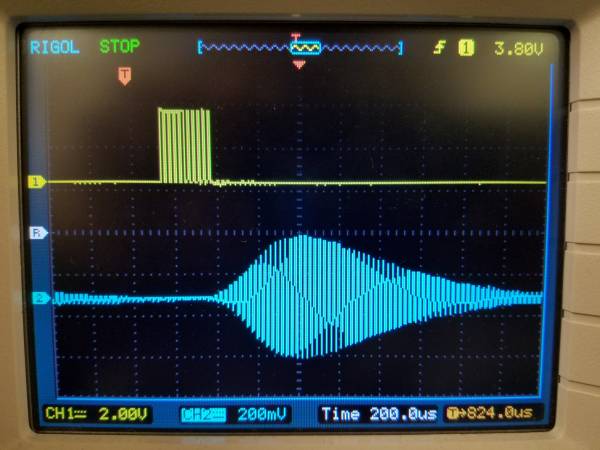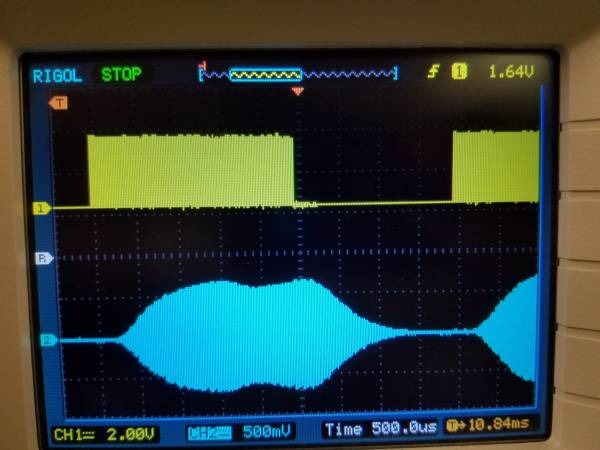Wind Sensor Team Meeting-April 7, 2017
Attended: Mengyuan, Creighton, Scott
Acoustic Wind Sensor
- Updates:
- Created a perforated board to mimic the traces on the pcb
- Single microphone test results were consistent for all four microphones.
- Conducted single microphone tests for all four microphones using several different fans and iterations
- Devised a method of collecting raw analog data for four microphones
- Collected raw data for all four microphones under 9 different fan settings repeated 3 times each.
- To Do:
- Analyze raw data results and real time processed results from single-microphone peak detector
Ultrasonic Wind Sensor
- Updates:
- We were initially concerned about the Teensy driving the emitter using a square wave that wasn't centered at 0V, since usually we would use a signal with amplitudes [-Vpp/2, Vpp/2]. However, after comparing the received signal when driving the emitter using a square wave centered at 0 and centered at Vpp/2, we determined that it didn't matter. However, it should be noted that our results were at steady state, and we didn't observe the transient response, which might be useful.
- We were also concerned with the current draw of the transducer. The Teensy can only safely output about 20mA of current. We weren't sure how to directly measure the current draw of the transducer, so we designed an experiment to calculate it.
- Our results showed that at 40kHz, the transducer had an impedance of around 1.7k. Given that we are driving it with 3.3V, that puts our current draw to around 2mA, which is ten times smaller than our current limit.
- Experimented with sending bursts of 41.67kHz pulses with the Teensy and observed the response on the oscilloscope. Below is the response of sending ten response, and below that is the response of sending a hundred pulses with a short delay.
-
- We observed that the receiver takes some time to “ramp up” to a distinguishable voltage and it also takes some time to “ramp down” after the signals have passed.
- This ramping up and down may cause some issues when we're trying to determine our propagation time. We shouldn't rely solely on our threshold detector to measure the propagation time since the “ramp up” part of the response is unreliable.
- A smarter way would be to estimate the possible propagation times and to either discard a received pulse if it is too early, or too late. We can do this because we know the temperature and distance, so we know the propagation time with no wind. Then, we can choose a max and min wind speed to get our max and min propagation times, which we'll use to make sure our measured propagation times are within the boundaries.
- Another problem is that the received signal is centered at 0V, which means that the ADC is unable to read the negative portion of the signal. We need to find a way to shift the received signal up and center it at half our reference voltage (1.67V).
- To Do:
- Consider testing the emitter using a square wave centered at 0V and observe the transient response vs. using a square wave centered at Vpp/2.
- Work on determining the max and min propagation times and how effective the method of checking whether or not the measured propagation time is within the boundaries is.
- Experiment: tie a hardware interrupt to the Teensy so that when it crosses the high threshold, it sends a pin to HIGH, and when it crosses the low threshold, it sends a pin to LOW. Then, on the oscilloscope, observe how precise the threshold detector is (precise means consistently setting the pin to HIGH or LOW at the same received input amplitude).
- Implement a voltage offset for our received signal so that the signal is centered at 3.3V/2 = 1.67V.
- Design a multi-stage amplifier circuit attached to our receiver to amplify the signal so that the Vpk-pk is around 3V and has a band-pass response centered at the operating frequency. Need to find an amplifier with a slew rate of at least SR = 2*pi*f*Vamp = 2*pi*(41.67kHz)(1.5V) = 0.393 V/us.
Authors
Contributing authors:
Created by mwu on 2017/04/08 08:20.

